In times past, one of our most precious items was our funky ferments. Like seeds, they were future food, something to respect, look after, eat, share and pass down the generations. If we think about it, it is quite marvellous that a treasured item keeps multiplying and can be shared. Every country has many fermented or cultured food, some are part of the national identity, such as kimchi in Korea.
Nomadic herders of the Steppe were dependent on their flocks and their milk which sometimes was the only source of food or drink. Dairy products were known as white goods, which were and still are held in high esteem. When milk ferments it keeps for slightly longer but, more importantly, it is more nutritious and bioavailable to humans most of whom are lactose intolerant. There are some who posit that it was fermentation not fire which led to human evolution!
One such white good is milk kefir or chefir (as we say in Azeri) which originated in the Caucuses. Kefir is both the name of the ferment and the SCOBY (symbiotic culture of bacteria and yeast) which are also called kefir grains. The grains are cream coloured clusters of small blobs like slimy cauliflower, I’m really selling it aren’t I? There are over 50 different probiotic bacteria and yeasts in kefir grains. Simply put, the yeasts convert sugars into ethanol and carbon dioxide, making it fizzy, and the bacteria turn lactose into lactic acid, giving it its sour taste. Kefir grains cannot be made and don’t dissolve in liquid; rather they multiply and pass on their properties into the substrate. They are very stable and can be retained for generations. Some say that the grains we have today are from the first grains to exist. I find that quite profound and it makes me feel a sort of kinship with my kefir.
Looking into the etymology of kefir, it is a Turkic word. In some references it is from kef, meaning pleasure, enjoyment or even drunkenness. In others it is from the word köpür, which translates to fizz, froth or foam. I’m more inclined to this definition and would like to add, to bloat, to this selection as well. They are all good descriptions of what happens to the milk, the resulting kefir and the effects of consuming it, no wonder some call it dairy champagne.
There are many stories about its journey out of the Caucuses. The one I like the most is how the charms of a beautiful woman were used to deliver kefir grains to “outsiders” (Russians) and then the rest of the world. Now kefir is made and consumed all over the world, and is part of the “functional foods” category which are a growing product range on supermarkets’ refrigerated shelves.
Magical kefir has been treasured for millennia. We are able to explain this magic by using genetic analysis to look at kefir genes. Kefir has an astonishing array of health benefits, for example, improving our metabolic health, as a tumour suppressant, wound healing properties and it can alleviate some allergies and asthma, just to name a few.
Earlier this year I took part in the Zoe nutrition study to find out about my biology. Having read about all the benefits of kefir and how easy it was to keep and make whilst researching for a book, I thought I’d treat my body (a hotel for bacteria as I like to call myself) and get some. No one I knew had any. I posted on my local social media page asking for some, and soon I had a DM telling me to collect them whenever I was passing. It didn't even occur to me that I was collecting something I was going to eat from a random stranger and that they could be harmful. It was only after a friend commented saying “it was trusting of me to do so”, I realised this. It could also be that people who share food and especially ferment starters are usually well meaning so if you are worried, buy kefir grains.
When I went to fetch the kefir, the door opened and two people with rosy cheeks and glowing skin answered. I was invited into their kitchen, and I’m sure they won’t mind my saying, it was full of cats and cat paraphernalia. It transpired Helen was a naturopath and she and her husband had had the kefir for years. Moreover, they had both seen improvement in their health since taking it daily. She also kindly gave me a mini lesson in how to keep the kefir going. She strained the cloudy liquid into a cup using a little sieve, and then rinsed the grains and the jar with tap water. After drying the jar, she put the grains back in, topped it with milk, and put it in the fridge. She said when the grains grew she threw them in the bin. She gave me about tablespoon,10g.
I came home that late May evening, put the grains in a glass jar, topped it with pasteurised organic semi-skimmed milk, put a piece of kitchen paper on top and left it on the counter. After three days I strained a bit, and drank it cautiously. I’d had kefir before and not liked it, this one was delicious though. I topped it up with milk regularly and drank some daily. From late June I transferred the jar into the fridge, by which time the grains had grown and I’d shared them with my sister and a school friend. I always added the same amount of milk when topping up, and, as the grains grew, it was becoming thicker. The yoghurt we get in Tabriz is more sour than the natural yoghurt we get here in Bath and I wanted to substitute kefir for yoghurt to eat with food, rather than have it as a drink. One can also use kefir in quick breads and other bakes instead of buttermilk but we have to remember heat destroys the benefits. I have thought of using it in salad dressing or cold soup.
On the 7th of October, I decided to give my kefir a bath and wash the jar. By this time the grains had grown to 60g and were still in the same unwashed jar with its community of microorganisms. A bit like turning over soil in the garden, I do it, but I also worry about disturbing all the good stuff. Anyway I had to wash the jar. I chose to use dechlorinated water to wash the kefir, to do this I boiled 2 ltrs of water, left it in a jug overnight to get rid of the chlorine. The next day I bathed the grains in this water. I also washed the jar and have restarted the process of topping it up and leaving it on the counter now the weather is cooler.
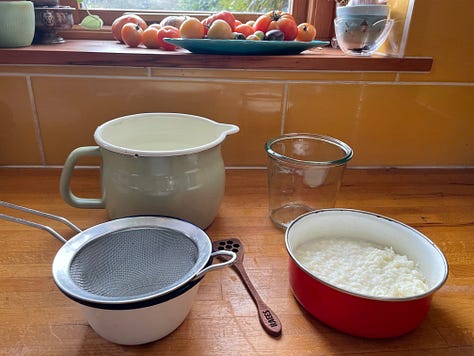
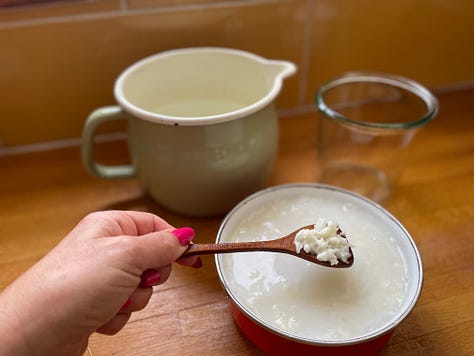
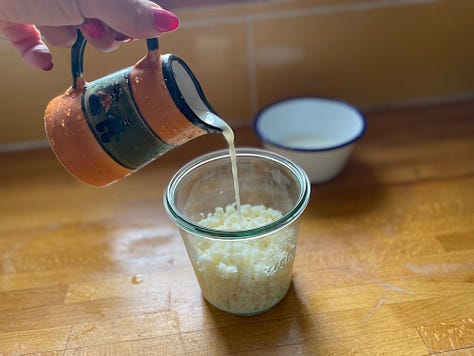
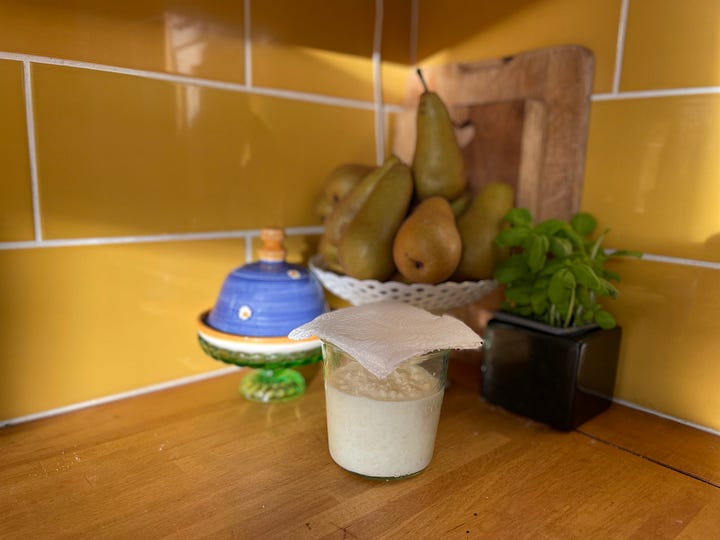
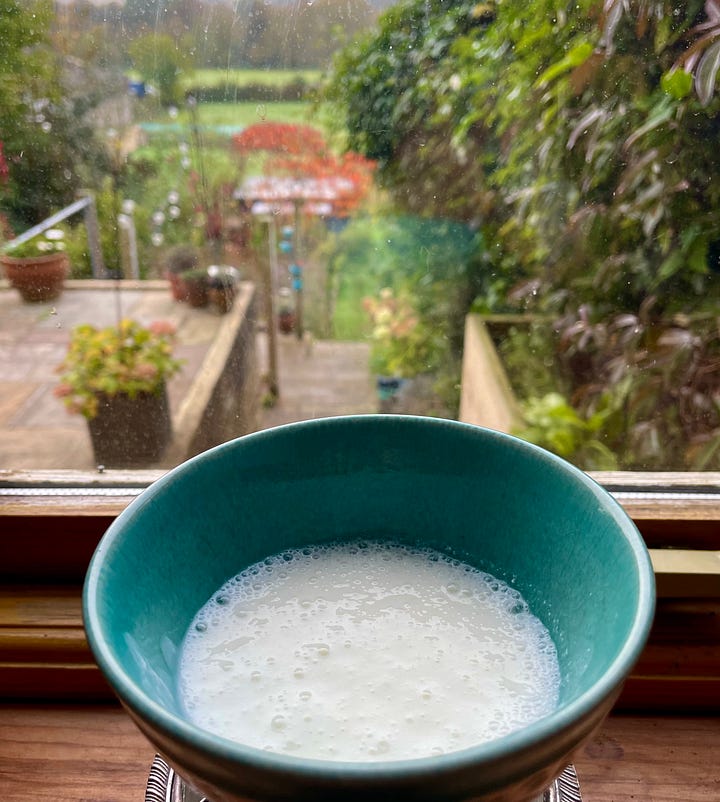
I’ve shared what Helen’s home was like and how she treated her grains as well as what I’ve been doing, to illustrate that there is no one right way to make or keep fermented foods. You can have some fun with them. With all food and especially ferments, your judgment and preference is key: check how it looks, smells and if it is to your taste. There are so many variables affecting these living things such as the milk you use, the season, what it comes into contact with, time and temperature and they will all affect the taste and texture of the resulting ferment. If any of your ferments don’t work or die, it might not have anything to do with you, get another lot and try again.
I have enjoyed having and sharing my kefir and am thrilled that it is still going well. It has become a glimmer (a little moment of joy as apposed to a trigger) in my day. Whilst straining the kefir I thank it and I say “soghlughumuza”, which means to our health. This behaviour isn’t as odd as it sounds, I know a few people who have named their kombucha SCOBY!
If this has tempted you to get some grains, please do and raise your small champagne bowl, flute or tulip to you and your kefir’s health.
More in my upcoming book Fermented Dairy of Central Asia, due out in 2025.
If you enjoy this piece please let me know by tapping the ❤️ at the top or bottom or share — thank you.




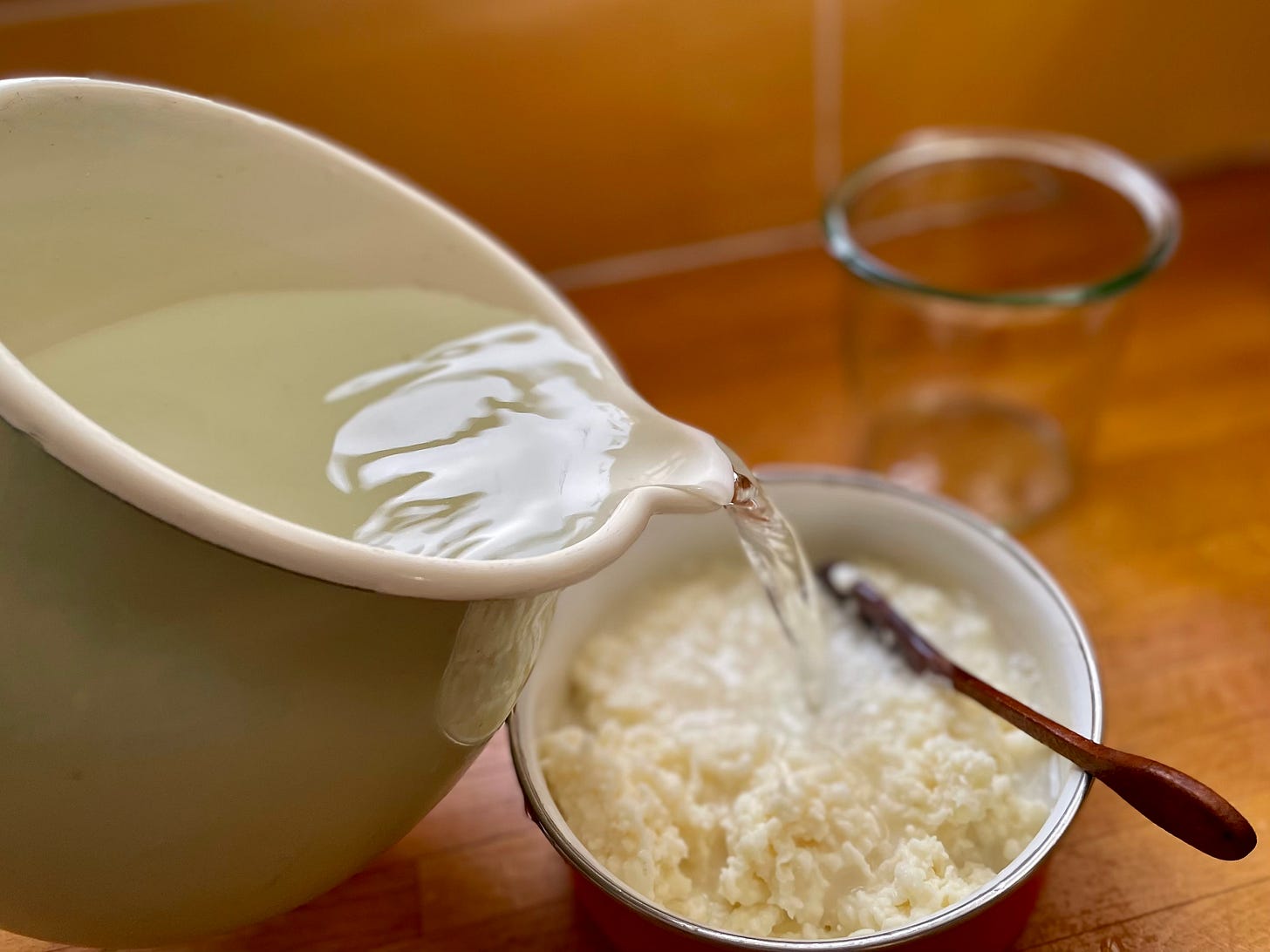
I regularly buy and drink commercial kefir these days since it now is present on all our supermarket shelves. But what a joy it has been to read about the science, the history and the culture (excuse the pun!) of kefir. Thank you Simi.
I've made water kefir but never dairy kefir. You make it sound so delicious!